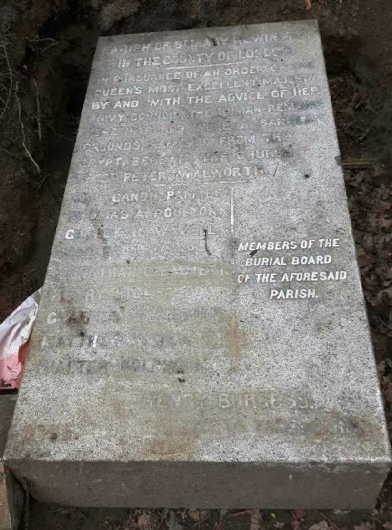

© John Clarke 2014-
John Clarke
Historian of Brookwood Cemetery

St Peter’s Walworth Reburials
 DURING early February 2021 the Brookwood Cemetery Management were trying to locate a grave in plot 85 in the South Cemetery. The work party decided to investigate a large allotment with solid grey granite kerbing. They discovered deeply buried a massive granite block with a lengthy inscription commemorating the reburials of parishioners from St Peter’s Church Walworth in 1894.
DURING early February 2021 the Brookwood Cemetery Management were trying to locate a grave in plot 85 in the South Cemetery. The work party decided to investigate a large allotment with solid grey granite kerbing. They discovered deeply buried a massive granite block with a lengthy inscription commemorating the reburials of parishioners from St Peter’s Church Walworth in 1894.
As can be seen from the photograph, the monument was covered by a considerable amount of topsoil, and thereby escaped notice in previous explorations of the area. Similar to other reburial plots in this part of the cemetery, the memorial records details of the event, but differs in appearing to be a massive ledger stone made of grey granite and measuring 6 feet by 3 feet by 2 feet deep.
The St Peter’s Walworth monument in plot 85
The memorial is inscribed as follows:
Parish of St Mary’s Newington
In the County of London
In pursuance of an Order of the Queen’s Most Excellent Majesty by and with the advice of her Privy Council the human remains here interred on sanitary grounds removed from beneath the church of St Peter’s Walworth.
Rev. Canon Palmer Members of the Burial
Thomas Poulton Board of the aforesaid
George Wavell Parish
Walter Crisp
Jonathan C. Emmett
Henry Hicks
Charles Simmonds
Matthew H. Newton
Walter Colbrook
Henry Burgess Clerk to the Board
1895
There are a number of memorials relating to reburials at Brookwood, particularly in plots 81, 85 and 87 along St Andrew’s Avenue.
The process of removing human remains from churches is quite a long drawn out process, beginning with the Vicar and Churchwardens seeking advice from the Medical Officer of Health. In the case of St Peter’s, this meant approaching Dr. George Millson, who was the Medical Officer of Health for Saint Mary, Newington. Dr. Millson then arranged to make a formal inspection of the crypt and submitted his report to the Churchwardens. Usually inspection of the crypt revealed disintegrating coffins, often alongside human remains without coffins. In the worst cases, “offensive and obnoxious effluvia” from these remains meant the church became unfit for public worship. The crypt of St Peter’s was described at the time by its new Vicar, Rev. John Horsley, as:
…of great size, dark, though with many unglazed but barred windows, so that a taper was necessary to guide one through the piles of coffins stacked up like egg-
The next stage was for the Churchwardens to forward the report on the state of the crypt to the Secretary of State for the Home Office with a formal request for the removal and reburial of the human remains. At this stage formal legal proceedings began. An Order in Council was necessary, involving the Secretary of State requesting permission for the reburials to take place under the authority of the Privy Council and the Queen. In the case of St Peter’s, the Order in Council was authorised at the Court at Windsor on 30th April 1894. This declared:
Her Majesty, by and with the advice of Her Privy Council, is pleased to order, and it is hereby ordered, that the said churchwardens do adopt, or cause to be adopted, the following measures, viz.:— That the whole of the human remains now lying in the crypt beneath the church of Saint Peter, Walworth, be forthwith removed under the supervision and to the satisfaction of Doctor G. Millson, the Medical Officer of Health of Saint Mary, Newington, and reburied in the consecrated part of Woking Cemetery. [2]
The next stage was to publicise the forthcoming work. Notices were placed in newspapers to alert parishioners and relatives to the removal of bodies from the crypt:
ST PETER’S CHURCH, WALWORTH.
AN ORDER having been received from the Queen in Council directing that the whole of the HUMAN REMAINS now lying in the crypt beneath this church be forthwith REMOVED and RE-
By order of the Board
HENRY BURGESS, Clerk.
Vestry Hall, Walworth, May 23 1894. [3]
The main task of identifying the remains by coffin plates, clearing the crypt and removing the coffins to Brookwood for reburial then began. Further particulars of this operation are not known, but the vicar referred to “247 unburied corpses or sets of bones” in his memoirs. [4] All were removed from the crypt, transported to Brookwood Cemetery by rail, and reburied in this plot. From the evidence of the Clutton and Hammond reburials (see below) it appears this operation took several weeks, and was probably completed by the end of June.
The final task was to commission the monument that has recently been unearthed, to mark the resting place of these former parishioners of St Peter’s. This was almost certainly placed some time afterwards, and the transcription implies it was erected in 1895.
What of the vacant crypt? It was soon transformed by the installation of new glazed windows and gas lighting. One aisle was partitioned off to make a Sunday school. Old recesses or rooms were filled with cookers which each winter produced the soup which provided hundreds of thousands of meals not only to the children of the immediate neighbourhood but also to more distant Church, Roman Catholic and London County Council schools, all supplied by carts operating from St Peter’s Church. Other parts of the crypt housed a Cadet Corps and Boys’ Club. Every Monday the “Penny Bank” met there, and occasional parties were held, especially at Christmas. [5]
We previously noted that it was possible for families to claim the bodies of relatives previously buried in the crypt. It is therefore interesting to find that two such families decided to do so, and to have the coffins buried in separate private graves at Brookwood, rather than in the general reburial plot. Thus the coffins of Owen Clutton, John Clutton and Elizabeth Amelia Clutton were buried next to those of W. B. Hammond on 24 June 1894. These graves may be found at the top of plot 73. In the latter case, W. B. Hammond’s coffin was number 229 amongst those identified in the crypt, giving an idea of the scale of this project. Unfortunately the registers do not state the coffin numbers for members of the Clutton family. Subsequent burials took place in each of these graves, the Hammond family eventually purchasing six further grave spaces in front of the original pair.
Notes
[1] Rev. John William Horsley I Remember: Memories of a “Sky Pilot” in the Prison and the Slum London: 1911, p.259.
[2] The full Order in Council was published in The London Gazette, 4 May 1894, p. 2591.
[3] Facsimile of a notice published in The South London Press, 26 May 1894.
[4] Rev. John William Horsley, p.259.
[5] Rev. John William Horsley, pp.259-
Margaret Hobbs & John Clarke
Copyright © 2021 by John M. Clarke All Rights Reserved